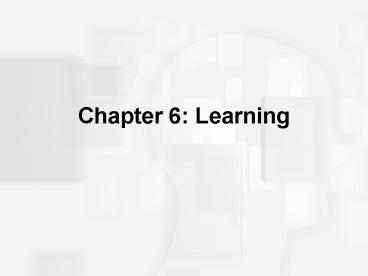Chapter 6: Learning - PowerPoint PPT Presentation
1 / 27
Title: Chapter 6: Learning
1
Chapter 6 Learning
2
Classical Conditioning
- Ivan Pavlov
- Terminology
- Unconditioned Stimulus (UCS)
- Conditioned Stimulus (CS)
- Unconditioned Response (UCR)
- Conditioned Response (CR)
3
Figure 6.1 Classical conditioning apparatus
4
Figure 6.2 The sequence of events in classical
conditioning
5
Figure 6.3 Classical conditioning of a fear
response
6
Classical Conditioning More Terminology
- Trial pairing of UCS and CS
- Acquisition initial stage in learning
- Stimulus contiguity occurring together in time
and space
7
Classical Conditioning More Terminology
- 3 types of Classical Conditioning
- Simultaneous conditioning CS and UCS begin and
end together - Short-delayed conditioning CS begins just before
the UCS, end together - Trace conditioning CS begins and ends before UCS
is presented
8
Processes in Classical Conditioning
- Extinction
- Spontaneous Recovery
- Stimulus Generalization
- Discrimination
- Higher-order conditioning
9
Figure 6.7 Acquisition, extinction, and
spontaneous recovery
10
Figure 6.10 Higher-order conditioning
11
Operant Conditioningor Instrumental Learning
- Edward L. Thorndike (1913) the law of effect
- B.F. Skinner (1953) principle of reinforcement
- Operant chamber
- Emission of response
- Reinforcement contingencies
- Cumulative recorder
12
Figure 6.12 Reinforcement in operant conditioning
13
Figure 6.13 Skinner box and cumulative recorder
14
Basic Processes in Operant Conditioning
- Acquisition
- Shaping
- Extinction
- Stimulus Control
- Generalization
- Discrimination
15
Figure 6.14 A graphic portrayal of operant
responding
16
Table 6.1 Comparison of Basic Processes in
Classical and Operant Conditioning
17
ReinforcementConsequences that Strengthen
Responses
- Primary Reinforcers
- Satisfy biological needs
- Secondary Reinforcers
- Conditioned reinforcement
18
Schedules of Reinforcement
- Continuous reinforcement
- Intermittent (partial) reinforcement
- Ratio schedules
- Fixed
- Variable
- Interval schedules
- Fixed
- Variable
19
Figure 6.17 Schedules of reinforcement and
patterns of response
20
ConsequencesReinforcement and Punishment
- Increasing a response
- Positive reinforcement response followed by
rewarding stimulus - Negative reinforcement response followed by
removal of an aversive stimulus - Escape learning
- Avoidance learning
- Decreasing a response
- Punishment
- Problems with punishment
21
Figure 6.18 Positive reinforcement versus
negative reinforcement
22
Figure 6.19 Escape and avoidance learning
23
Figure 6.20 Comparison of negative reinforcement
and punishment
24
Changes in Our Understandingof Conditioning
- Biological Constraints on Conditioning
- Instinctive Drift
- Conditioned Taste Aversion
- Preparedness and Phobias
- Cognitive Influences on Conditioning
- Signal relations
- Response-outcome relations
- Evolutionary Perspectives on learning
25
Figure 6.22 Conditioned taste aversion
26
Observational Learning Basic Processes
- Albert Bandura (1977, 1986)
- Observational learning
- Vicarious conditioning
- 4 key processes
- attention
- retention
- reproduction
- motivation
- acquisition vs. performance
27
Figure 6.25 Observational learning

